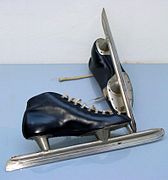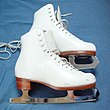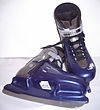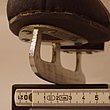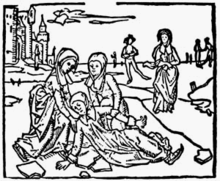Ice skate
Ice skates (also ice skates ) are special shoes for ice skaters with runners for gliding on ice surfaces or synthetic ice . Moving around with ice skates is referred to as ice skating, ice skating or ice skating and is mainly done using the ice skating step .
Sports that are performed on different types of ice skates are figure skating (including ice dancing ), ice hockey , ice freestyle and speed skating .
figure skating
Skating -Schlittschuhe have up to the calves high-necked lace-up boots with 3-4 mm thick steel runners with hollow ground in the transverse direction and a slight curvature in the longitudinal direction. At the front tip there are jagged edges for jumping off the jumps, turning the pirouettes without changing edges and performing a few steps. The spikes are needed to jump off Toeloop , Flip , Lutz and other jumps.
The shape of the figure skate has not changed much visually over the decades. The range of men's models in particular has decreased significantly, and recreational runners are now more likely to prefer ice hockey skates.
Ice hockey skates
Ice hockey skates are mostly used for ice hockey or related games, but are also often used by runners who appreciate the agile running properties.
Up until the 1980s, ice hockey skates were made of leather and had a blade made entirely of chrome-plated steel. With regard to the construction, there are now a large number of versions, most of which only have the shape of the runners in common. Runners with corresponding properties are older than the sport itself.
The biggest difference between rental skates and conventional ice hockey skates is that they have a ratchet lock and a hard shell (the dynamic properties are severely limited). In general, the shape of the attached lace-up boot that extends over the ankle has been preserved up to the present day, the lacing enables precise adaptation to the foot. The materials used are mostly high-quality plastics (Kevlar, ballistic nylon, special plastics) with additional heel or Achilles tendon protection and about 5 mm thick steel runners with hollow grind in the transverse direction and a slight curve in the longitudinal direction.
Typical for ice hockey skates are short model cycles and sometimes optically similar models in different quality levels. The weight is therefore often used as a comparison, which nowadays is around 650 to 800 grams per shoe, whereby the shoe size must also be taken into account.
In 2012, the Bari Rookie, a street boot based on ice hockey skates, was produced.
- Runners
- The runners are connected to the boot with rivets. Ice hockey blades are designed for maneuverability, which is why they are shorter than the speed skating blades designed for speed. The rocker and the hollow grind of the runners are decisive for the maneuverability .
- rocker
- The rocker describes the length of the contact area that results from the longitudinal curvature. The shorter the contact area, the more agile and unstable the shoe becomes against tipping forwards and backwards. Strikers therefore use shorter rockers for tight turns, defenders use longer rockers to increase stability.
- Radius of the hollow section
- The runners are ground with a hollow grind so that they only stand on the ice with the two edges. The measure of the cut is the radius of the circle that would fit into the hollow cut. The smaller the radius, the sharper the runner. When choosing the radius, the weight of the runner, the hardness of the ice (the softer the ice, the larger the radius) and the way of running can be taken into account.
Ice hockey goalkeeper
Ice hockey goalkeeper skates are cut lower at the ankle than ice hockey skates. The center of gravity is very low. The boot itself is coated with hardened plastic known as "cowling" that protects the toes, ankles and heel from being shot. The runner is usually longer and less rounded.
Speed skating
Speed skating ice skates have lace-up shoes that reach below the ankle and were originally made of goatskin. The long steel runners, also called “bread knives”, are about 38 to 45 centimeters long and about 1.3 to 1.5 millimeters thick. The running surface has a flat grinding with a slight curvature in the longitudinal direction, which is intended to prevent the blade from “digging” into the ice. The tip is rounded, the rear end sloping obliquely backwards from above.
In contrast to pushing off the back in art skating, the speed skater pushes himself off in a straight line with his legs to the side, whereby the runner remains in contact with the ice surface over its entire length. Although the long runners are supposed to stabilize the straight-line stability, the forced push-off technique leads to a much more pronounced zigzag course. Nevertheless, the highest possible speed on the ice is achieved.
The last stage of development is the folding ice skate , in which the runner folds down when the heel is lifted with the buttock extended and is only pulled back when it is finally lifted off. Top athletes can reach a continuous speed of 45 km / h for several kilometers or several minutes on ice skates, and for a short time up to 60 km / h in the sprint.
functionality
A thin layer of liquid water forms between the skate blades and the ice. This layer of water means that the sliding friction in the direction of the runners is very low. At 0 ° C, ice has a layer of liquid a few nanometers thick on the surface, which becomes thinner at lower temperatures. However, this layer is far too thin to explain the low friction. However, due to friction during movement, enough heat is generated that the ice melts locally and forms a sufficiently thick layer of liquid. This process regulates itself. As soon as a sufficiently thick layer of liquid is present, the generation of additional heat decreases along with the friction. It goes with this explanation that a stationary skate blade shows a clearly noticeable static friction against the ice.
Since the skier's weight is concentrated on a small area, a high pressure is created on the runners, which pushes the edges of the runners a little into the surface of the ice. The resulting “groove” in the ice prevents the runner from slipping sideways. When the shoe is tilted, the leg can support itself against this resistance in order to use the force to drive it. The steady movement is achieved by alternately pushing off with the skate on one leg and sliding on the other foot. Since the frictional resistance on the liquid layer is much lower than on solid, dry materials, a high speed is achieved with relatively little force.
For the load-bearing capacity of ice sheets on bodies of water, see: Load-bearing capacity of the ice
The term
In Kassel the word “step shoe walking” had become established. Goethe pointed out an application by Homer that was translated as sledge and describes the godlike gliding across the sea, and locates the error in northern Germany. He also thinks the term “crotch skating” is more appropriate than ice skating. There is no longer any doubt about the term “ice skating”.
Elaborate (often imported) specimens were known as patent ice skates in the 19th century.
Application history
About 800 years ago in the Netherlands, messengers with iron runners on wooden shoes slid across the frozen canals and in this way delivered urgent messages to noble recipients. In the centuries that followed, ice skating initially became a pleasure for the nobility and later also a popular sport. The first ice-skating clubs were founded in Great Britain in the mid-18th century and a famous ice-skating competition was held for the first time in the Fens of Cambridgeshire in 1763 .
In general, ice skating was particularly popular in northern areas with inland waters, such as in Friesland and the Netherlands. In Germany, popularity was limited to the youth for a long time. Through literary accounts such as von Klopstock's odes "The Ice Skating", "Braga", "The Art of Thialfs", ice skating became a popular pleasure for the bourgeoisie from the 18th century, and one of the first artificial ice rinks was built in the Frankfurt Palmengarten.
After Klopstock had introduced Danish ice skates in Germany, Johann Wolfgang von Goethe was one of the first ice skaters in Frankfurt.
Ice skating in the Rococo, engraving by Daniel Chodowiecki , 1774
In the traditional Dutch Elfstedentocht , eleven Frisian cities were driven through in one day and about 200 kilometers were covered. Since the increasingly warmer climate prevented the Elfstedentocht from being held, other ice skating marathons have been established since 1990, such as the “ Vikingarännet ” (approx. 80 km) from Uppsala to Stockholm and the Weißensee ice skating marathon.
On the Danish islands, ice skating was accelerated by a sail attached to the back, so a Frisian could cover a distance of 160 Dutch cubits (about 100 meters) in 14 seconds. In large cities with small ice rinks, on the other hand, art skating was more pronounced. First place was taken by New York City , and masters from there like Jackson Haines made school in the European capitals. Between 1840 and 1875, ice hockey on ice skates was defined in Canada from various team sports . Eventually, very similar older games in Europe were replaced by ice hockey.

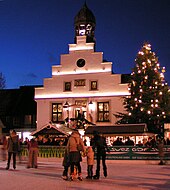
In big cities there are special artificial ice rinks outdoors or indoors. On these mostly rather small ice surfaces, the short track speed skating competitions developed on 111 meter long circuits. Nowadays these halls are partly operated all year round and offer training opportunities for figure skaters and ice hockey clubs as well as a wide range of public runs. The ice disco is a special offer that aims to rekindle young people's appetite for ice skating. The ice rink is also a meeting point for young people of all ages. With the invention of synthetic ice, there is also an alternative to the infrastructure-intensive artificial ice rink, which gives ice sports the potential to become a popular sport.
environmental Protection
The Biological Protection Association Hunte Weser-Ems points out problems with ice skating on smaller frozen bodies of water and asks you to refrain from doing this there: Almost all fish and amphibians living in the water are very sensitive to external stimuli, water currents and pressure fluctuations due to special senses, the so-called lateral line organs . Above all, the vibrations and sound waves that are caused by the jumping and falling of the ice skaters and by the crunching of the skate blades make the sensitive animals startle from their winter rest. Your metabolism is boosted, your heartbeat and breathing intensified. This increases the oxygen consumption considerably. However, due to the frozen water surface, oxygen quickly becomes scarce. In addition, the sudden activity of the fish increases harmful swamp gases from the mud. However, since these cannot escape through the ice cover, they represent a deadly danger for living beings under water. Instead, deeper, larger lakes, flooded meadows and artificial ice rinks should be used for ice skating.
In Germany, an estimated 2160 pairs of ice skates are disposed of every year. Modern ice skates in particular are difficult to separate, but on the other hand they are more durable and there is a second-hand market that extends the life of the pairs.
History of the ice skate

When and how it occurred to people to take advantage of quick and easy movement on frozen ice surfaces is not exactly clear. There are no reliable records about this. Since the hunt meant not only skin and meat , but also bones , which were then used to make various instruments, an invention in the course of hunting technology is not unlikely.
Animal bone ice skates could be found in Russia , Scandinavia , Great Britain , Germany , Switzerland and elsewhere. Native Siberia ran on walrus teeth, in China they used bamboo rods .
Scandinavian legends like the Edda tell of ice games from the time of the Norwegian King Sigurd Jorsalfari . The sir of Germanic mythology dominated the art of ice skating, and even the adoption of Christianity did not force descendants of the courageous men to stop the “divine” way of moving.
Bone ice skates
At the beginning of the 20th century people in France dug up metacarpal bones about 60 cm long from cattle. Lateral parts of these bones were abraded, so it is believed that they served as ice skates. Their age is estimated to be around 20,000 years.
The oldest finds that can be identified with greater certainty as ice skates date from around 3000 BC. Ch. They were made from the lower leg bones of various animals. Horse, cattle, or reindeer bones were split, ground flat, pierced, and attached to the sandals. With a spear or two sharpened sticks you braced yourself into the ice and achieved remarkable speeds. Such “ice skates” were also found in rediscovered lake structures in Switzerland, but were used in almost all European regions.
One of the oldest ice skates in the world is probably a bone ice skate from Veselí u Trnavy ( Slovakia ). The British archaeologist VG Childe estimated its age at 5000 years. More unique ice skates that are around 4000 years old have been found near ancient Rome. Similar unique items were also found in the Scandinavian countries and Switzerland. In Central Europe, pig's foot bones, which were attached to the feet with leather straps, were initially used as sliding aids on the ice. The pig bones used for this were given the name " pork knuckle ".
In the 18th century, bone ice skates fastened with straps were still used in London; they were also in use in Norway and Iceland until the 19th century . Those bone skates that were as big as these little bone sledges were called Skidi or Öndrun in Old Norse .
Muller , the skating Ase of Edda , is described as the master in its use.
Wooden ice skates with iron blades
Wooden ice skates began to be used on a larger scale in Europe, especially in the Netherlands, in the 14th century . The base , in the shape of a foot, was made of wood and an iron fitting was initially set flat, later on edge. They were connected to the shoe with leather straps. Sticks were used to move (to run up).
As recently as 1863, a magazine reported on various runners ("rails") which, when mounted on boards, were better or worse suited for various running properties, including the thickness, length and curvature of the runners.
Steel runners to strap on
The oldest steel ice skates, estimated to be 2000 years old, were found in an ore foundry workshop of a Celtic master and are in the museum in Budapest . Around the year 1500 the Dutch began to use runners with two edges and a groove in between. The skater could now move without sticks. In the middle of the 19th century, the skate was attached to the heel with a screw. The fastening by means of screws on the side of the sole and the heel by A. Stotz in Stuttgart and the "Halifax improvement", which used a tensioning lever, also proved successful. These skates held as tightly as the sole itself without pinching the foot. These runners were used until the 1950s .
Metal runners firmly attached to the shoe
In the middle of the 19th century, steel runners were used in Scandinavia with the sole embedded in wood. They were attached with cross straps or as a lace-up shoe . In 1865 , the American figure skater Jackson Haines created all-metal ice skates that were directly attached to the shoe sole. This can be seen as the most far-reaching innovation. Later, the Swedish figure skater and 10-time world champion Ulrich Salchow began to use ice skates with teeth, which enabled powerful pushes for running and jumping. In 1907 , the Russian figure skater Panin came up with a new model of ice skate that was lower than Salchov's; the teeth were also somewhat underlaid. In addition, this model was lighter than the previous one.
to form
Touring ice skate (Nordic style, cross-country ski binding )
The patron saint of ice skaters
The skaters have their own patron saint, Saint Lidwina of Schiedam . The story passed down from the 15th century tells that the then 15-year-old named Lidwina collided so violently with another skater in 1395 while skating that she was seriously injured. After convalescence, she went to a monastery and devoted herself to religious life until her death in 1443. Because of the ice-skating accident, she became the patron saint of ice-skaters.
Historical literature
- Ice skating or step-skating, a paperback for young and old. With poems by Klopstock, Göthe, Herder, Cramer, Krummacher etc. edited by Christian Siegmund Zindel. Campe Nuremberg, 1825.
- Franz Gräffer : Ice skating, a practical guide for quick and correct self-learning of this enjoyable, invigorating and noble art, along with some additions . Haas, Vienna 1827.
- G. Carl: The art of ice-skating is regarded as a branch of the art of gymnastics, as is safe instruction, the art. Tours without danger and to learn in a short time. Euler, Mainz 1847.
- George Anderson: The art of skating . London 1867
- HE Vandervell, T. Maxwell Wetham: A system of figure-skating, being the theory and practice of the art as developed in England, with a glance at its origin and history . Horace Cox, London 1874.
- W. Swatek: The ice skating. Theoretical-practical instruction. , Vienna 1874; Figures , that. 1885.
- Demeter Diamantidi , Carl von Korper, M. Wirth: Tracks on the ice. The development of ice skating on the track of the Vienna Ice Skating Club . Hölder, Vienna 1881.
- Wilhelm Brink: the art of ice skating . (With 181 drawings). Plauen 1881.
- Franz Calistus: Art of Ice Skating . Hartleben, Vienna 1885.
- Max Wirth : On the wings of steel . In: The Gazebo . Issue 52, 1867, pp. 825–831 ( full text [ Wikisource ] - illustrated).
- Friedrich Gottlieb Klopstock : The ice skating . ( Memento of October 18, 2007 in the Internet Archive ) 1764
Web links
- The virtual ice skating museum (Dutch, English)
- Physical explanation of ice skating (world of physics)
- Smooth gliding - Scientists discuss how ice skates whiz across the ice . Telepolis
- Blade Night Kiel ( Memento from February 3, 2002 in the Internet Archive )
Individual evidence
- ^ A b Wilhelm Angerstein: Introduction to the establishment of gymnasiums for every age . 1863, p. 234
- ^ A. Lied, H. Dosch, JH Bilgram: Surface melting of ice Ih single crystals revealed by glancing angle x-ray scattering . In: Phys. Rev. Lett. , 1994, 72, pp. 3554-3557.
- ↑ Why is the ice so smooth? comprehensive article on the DPG website
- ^ Journal of the Association for Hessian History , JJ Bohné, 1911, p. 302
- ↑ Journal for Comparative Linguistic Research , No. 18, p. 185
- ↑ Frank Nager: The healing poet. Goethe and medicine. Artemis, Zurich / Munich 1990; 4th edition, ibid. 1992, ISBN 3-7608-1043-8 , p. 108.
- ↑ As long as it cracks, it lasts. World's largest natural ice rink . In: Die Zeit , No. 48/2010
- ↑ Sonja Lübbe: Better ice skating on larger ice surfaces January 15, 2010
- ↑ Umweltbundesamt.de (PDF) accessed October 17, 2017
- ↑ Beate Kocher-Benzing: A bourgeois winter pleasure . In: From the Antiquarian Bookshop , Volume NF 13 (2015) No. 1, pp. 26–30.

